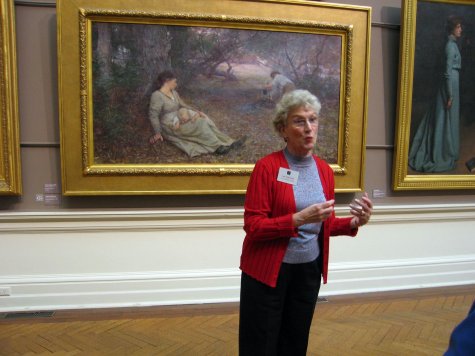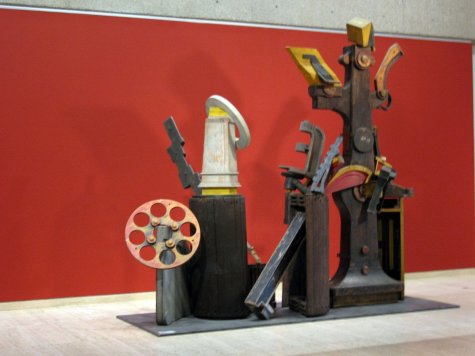Looking west down the McElhone stairs was Woolloomooloo, and central Sydney beyond that.
We had mapped out a stroll to see the Sydney neighbourhoods, so we proceeded down the stairs.
Wended our way west and north, we approached Cowper Wharf across a wide roadway, on the edge of Potts Point.
The fleet headquarters for the Royal Australian Navy precludes direct access to the waterfront at this point.
Just west of that gate on the boulevard, there’s a landmark diner, Harry’s Cafe de Wheels, that has served meat pies and peas since 1945. Most of us in the family are allergic to the milk products that go into the sauce and crust, but Adam and Diana were up for a mid-morning tasting.
Despite the mushy peas and gravy on top, the presentation is minimal with only a napkin and a fork. For customers who need two hands free, there’s a ledge on the side of the truck.
We wandered south and west, looking for the pedestrian bridge to continue our walk west. We found the stairs up by Wilson Street.
Climbing up to the top level on the footbridge, we looked back northeast to see the heights from whence we had walked.
Looking southeast, Woolloomooloo has a lower profile with residential and light industrial businesses.
If we hadn’t found the footbridge, we might have had a long walk trying to another crossing over the Eastern Distributor Motorway.
On the west side of the bridge, The Domain is large park with Sydney’s towers in the distance. We weren’t exactly sure where the Art Gallery of New South Wales would be. Walking north and west, we found a clue with an outdoor sculpture of two large matches, one burned. This installation titled “Almost Once“, by Brett Whitely, is on the southeast corner of the building. We walked around to the north side of the building to find the main entry.
The traditional architecture of the facade at the front of the building opens up to a modern space.
I prefer contemporary art. Upon seeing Ken Unsworth‘s 1994 “Rapture“, I knew that we had chosen a good destination for the afternoon.
The “Bugatti Type 35” tilted by 30 degrees in 2006 by James Angus led us to walk circles around the piece.
The twists on the bottom of the car are even more striking that from the top view.
We were in time for a guided tour, and our family was the only interested parties. Upon hearing that we were from Canada, our guide started with a historical context of Australian art, with John Glover leaving his native England for Australia in 1830.
Our guide was educational in describing how some of Australia’s history has been captured in its art.
Frederick McCubbin‘s 1896 painting “On the Wallaby Track” depicted a swagman travelling the outbook looking for work, setting up camp at the end of the day for his wife and child.
The 1899 painting by George W. Lambert titled “Across the Black Soil Plains” depicts a team of horses charging across the Australian countryside.
Tom Roberts‘ 1894 painting of “The Golden Fleece” (originally known as Shearing at Newstead), underscores the importance of sheep to the development of Australia.
Another painting by Tom Roberts in 1895 titled “Bailed Up” shows the lawlessness of the vast country in a stagecoach holdup by bushrangers.
The dangers of mining were captured by Arthur Streeton in the 1891 “Fire’s On” (Lapstone Tunnel) in putting the railway through the Blue Mountains.
Jumping from historic Australia to the more contemporary 2003, Robert Owen‘s “Cadence No. 1” represents a mapping of the weather over an 80-day period.
Bronze Sculpture No. 714, installed near the Hyatt Regency in the City of Adelaide, is over 3 metres high. It’s possible that more people see Robert Klippel‘s wooden prototype for Opus 714 in the gallery (even at a smaller scale).
Looking out the windows southwest from the gallery, we could see the wharf at Cowper Bay pier from where we had come.
Down from the main floor, on the wall of the stairwell is a large yellow neon installation by American artist Joseph Kosuch titled W.F.T #1 (yellow). The was created in 2008, as an extension of “The Language of Equilbrium” installation at La Biennale di Venezia. The Indo-European root branches out into Germanic, Latin and Greek.
We encountered a cluster of bee hives in the 1989 work of Australian artist Robert MacPherson, titled “20 Frog poems: distant thunder (a memorial) for D.M.“.
Touring the world, an Anish Kapoor installation of the 1989 “Void Field” was onsite when we were there.
Before the sun set, we wanted to check out another Sydney neighbourhood. We jumped on a bus that took us west out of The Domain to the city centre, and then walked in some circles to get to the right bus stop to take us southeast on Oxford Street. Randomly, we got off at William Street to walk back northwest.
The side streets are residential. The covered walkway on the north side of the street provides a welcoming atmosphere. Oxford Street curves to lead more directly west towards the city centre.
Diana looks for cheap chic, so we stopped in at the St. Vincent de Paul shop. We thought that our sons might want to get some extra clothes for the Australian winter, but they didn’t see anything they liked.
We continued walking west, with some larger hotel and bank buildings ahead on Oxford Street.
The cafe bookstore would have been a leisurely place to hang out if we had weren’t so intent on moving on.
The south side of the Oxford Street around the Victoria Barracks lacks interest. Further west, more shops line the south side.
Taylor Square is a major landmark where Oxford Street intersects with Flinders Street.
Although the large plaza in front of the Darlinghurst Courthouse was empty when we were there, Taylor Square would seem to be a hub for the the annual Gay and Lesbian Mardi Gras festivities, as well as weekly Sustainable Markets for local farmers.
As we continued walking west on Oxford Street, the covering over the sidewalks resumed.
Before we reached Hyde Park, the neighbourhood north of Oxford Street gradually became more upscale.
We walked over to Chinatown to have dinner with dinner with the Metcalfs at Bbq King. We had previously enjoyed the “duck hanging in the window” 1950s-era rice and noodles experience, so it was a reliable choice even just after our few days in Sydney.
After dinner, we all strolled along the pedestrian mall through Chinatown. This was like home for us, and we pointed out familiar items in the Chinese bakeries and shops to our friends.
[Start a large-image lightbox screen show over this blog post (in a supported browser)]
[See the Woolloomooloo webphotos album (with a slideshow option)]
[See the Art Gallery of New South Wales webphotos album (with a slideshow option)]
[See the Oxford Street webphotos album (with a slideshow option)]











































